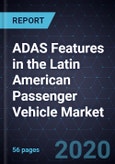The Introduction of Advanced Driving Assistive Systems (ADAS) is becoming Imperative Across Various Mid-size Segments in LATAM Markets
As the global automotive industry moves towards the development of fully autonomous vehicles and envisions a future without road accidents, the Latin American automotive market is making significant advances in the introduction of new advanced driving assistance features. Many Latin American countries have some of the most severe road fatality figures in the developing world and thus the region presents enormous opportunities for the introduction of new technologies that can help reduce those figures.
This study explores the different trends that are influencing the strategies that OEMs in Latin America are adopting to introduce advanced driving assistive systems (ADAS) features in their vehicle portfolios across multiple vehicle segments and selected countries in the region (Argentina, Brazil, Chile, Colombia, and Peru). Some of the trends discussed in the study include the impact of local regulations on vehicle safety and homologation standards, such as Brazil’s “Rota 2030” roadmap for enhancing vehicle safety and efficiency. The study also discusses the different OEM’s product strategies in terms of ADAS adoption across multiple segments and benchmarks each OEM’s strategy, competitive positioning, and portfolio offerings to identify those that are more advanced and ahead in the region. The OEM scope covers the 2019-2020 catalogs for 13 volume OEMs (Ford, GM, VW, Peugeot, Renault, Toyota, Honda, Hyundai, Mitsubishi, Fiat, Jeep, Nissan, and KIA). Finally, the study provides a vision towards 2025 of the respective OEMs’ tentative ADAS portfolios for the region and highlights key strategic imperatives for a competitive ADAS product strategy.
Key Issues Addressed
- What is the current automotive ADAS offering scenario in the South American vehicle market?
- How are new safety homologation regulations across South American markets impacting OEMs’ ADAS feature offering strategies?
- Which OEMs are leading in terms of introducing ADAS features in the region and across which vehicle segments?
- How are OEMs coping with these trends and the changing environment? How are they defining a strategy for the region towards 2025?
- What are some of the best practices and strategic imperatives in this market? Which ones will make a competitive difference towards 2025?








